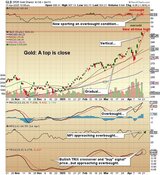Brien Lundin: I've never been a big believer that the government manipulates the gold price on a day-to-day basis. By and large you can't blame everyday fluctuations on the secret hand of some government bureaucrat. My feelings that they don't do this every day has nothing to do with motivation, but rather government inefficiencies. I don't think they could do it. However, they're certainly motivated to manipulate gold prices in a broader sense. That's something they have done, and I think they are doing it now.
The reasons I think it's foolish to believe that governments aren't manipulating the gold market in some broader sense are: 1) it suits their purposes; and 2) they've done it in the past. Gold serves as the barometer not only of government mismanagement of the currency but of investor and saver confidence in the currency. As such, the gold price has been marching higher relentlessly, which certainly can be interpreted as a decline in confidence in the dollar and in government management of finances.
Both overtly and covertly, government manipulation of the gold price dates back to 1933, when Roosevelt confiscated private gold that U.S. citizens owned and proceeded to revalue it, raising the official gold price from $20.67 an ounce to $35. That, in effect, devalued the dollar; but, because they did it after confiscating the gold, it's an example of overt manipulation.
After Bretton Woods, following World War II, in concert with foreign governments the U.S. government routinely manipulated the gold price, primarily with the establishment of the London Gold Pool in the 1960s. They tried in vain to suppress the price, to keep the exchange rate closer to the official rate of $35 an ounce. As with all such manipulations of the market, that eventually failed and the London Gold Pool collapsed.
After legalizing gold ownership again in 1974, the U.S. government immediately cratered the price through Treasury sales of gold, which resulted in tremendous gains for the U.S. Treasury and tremendous losses for private investors. Throughout the 1970s, those efforts continued through public Treasury auctions of gold, which obviously were designed to suppress the gold price. Of course, ultimately these efforts failed as well, because the gold price broke free in 1979 and hit record levels.
After that, gold leasing through bullion banks was used to depress the gold price for some time. That was the primary tool throughout the 1990s.
TGR: Did that work?
BL: As detailed in research by Frank Veneroso, which we first published in the late 1990s, gold from central government vaults was loaned to the market either through fabricators or miners using gold hedges to protect the price they received for gold and thus their profit margins. That's still being done to some extent for project financing, although not nearly as much as in the 1990s and the early 2000s. But bullion banks essentially hedged their positions with gold miners and gold fabricators, borrowing gold from central banks at very low interest rates and selling it into the market, which would depress the price. Then they reinvested the proceeds into more leveraged investments—at least T-bills, but often using T-bills as collateral for even riskier investments. In that manner, the official central bank gold holdings dropped from about 30,000 tons to less than 15,000 tons.
TGR: Wow!
BL: In effect, that's a large, accumulated gold short position. Citizens of a lot of nations don't realize that much of the gold they think sits in the vaults of their central banks is really a pile of IOUs that can't be settled with gold. These IOUs would have to be settled with cash at some level. That's a lit fuse, and it's been out there for some time. It's a potential X-factor in the gold market that could send prices higher much more quickly.
TGR: Any other examples of how government manipulation is manifesting itself now?
BL: One of the ways is simply through manipulation of the futures and options markets and gold derivatives.
TGR: Europe's problems also seem to be influencing the gold price. This week, just after Moody's downgraded Greece's credit rating to junk bond status there was a late—though small—rally in gold.
BL: Right. As you know, gold and the U.S. dollar were on opposite sides of a seesaw for some time; when one rose, the other one fell and vice versa. I've been arguing that gold's real breakout would come when gold could rise regardless of what happened to the U.S. dollar. That actually happened with the early troubles with the euro. Early this spring, when we saw the first signs of this, we reported on them in Gold Newsletter. For brief periods, gold began to rise even when the dollar was strong. It wasn't a very pronounced trend, but it was the first sign that the inverse correlation between gold with the U.S. dollar was weakening.
As troubles began to mount in Euroland, especially Greece's sovereign debt troubles, gold began to trade completely independently of the direction the dollar—in fact, both were acting as safe havens. The real impact of these problems, particularly among the PIIG nations, is that gold has regained its status as a reserve currency, not only in the minds of central banks, but also with individual investors and savers around the world.
Gold's been a currency for some 5,000 years of human experience, but in the last century or so it lost much of its allure as a reserve currency. Now, as the rest of the world's currencies lose favor, gold is rising as a more favorable alternative. We still have the dollar as a reserve currency, and probably right behind the dollar we have gold.
However, while gold may be the "ultimate currency," the dollar is the only currency accepted by margin clerks.
TGR: Is that what you meant in your June newsletter when you said the fact that gold that cannot be created at will—as dollars and euros are—is the most important factor in any secular bull market?
BL: Exactly. And it is the factor that has come to the fore.
TGR: What range are you forecasting for the gold price through the rest of this year and into next?
BL: The rest of this year looks very interesting. Once gold passed $1,000 again last fall, the breakout was so powerful and so similar to two previous breakouts during this bull market that Gold Newsletter began tracking the rally against them. Those breakouts occurred in 2005 and 2007, with a year of consolidation in between.
Our tracking made it appear that this rally would carry gold up somewhere between previous rallies' gains—which were around 75% and 57%—taking it to between $1,350 and $1,500. When the rally faltered in December and January, we thought the analogy might not hold, but then gold really got back on track this spring. Projecting this rally to the average length of those two previous rallies, we could get up to $1,400 by the end of this year. Even by the early fall.
TGR: Wow! And then do you see it going even higher than that in 2011?
BL: Another period of consolidation is very likely, but that's just looking at it from a technical standpoint, not in terms of fundamentals. It's very possible that we could see gold around $1,600 in 2011. But that's in current dollars. Based on the official CPI, gold would have to reach around $2,300 in today's dollars to equal its record price in 1980. However, the government has changed the CPI. People don't realize that in the 1980s and then again during the Clinton administration, the government jiggered the CPI to minimize reported inflation. Economists can argue whether these changes were justified, but the point is that they changed the unit of measurement.
If you look at the gold price measured in previous versions of the CPI, you're talking about far higher gold prices in current dollars. John Williams of Shadow Stats has gone back and recalculated what he calls the "Alternate CPI," which takes out the government's changes to the index. As it turns out, when you use the historical CPI that was actually in effect during the 1980s, that $850 gold price record in 1980 is equal to $7,576 in 2010 dollars.
TGR: Yikes! That's if we measured inflation by exactly the same methodology the U.S. Department of Commerce used in 1980. But that $850 level didn't hold for very long, did it?
BL: Oh, no. It gained a few hundred dollars in the span of a month to get to $850, and $850 actually just was a hyperbolic blow-off price. Even so, the current gold price has a long way to go before it even approaches such a blow-off stage.
TGR: One way you're taking advantage of this gold bull market is through gold equities. Could you update us on some of the companies you talked about when we interviewed you in March?
BL: I know we talked about Linear Gold Corp. (TSX:LRR) last time around.
TGR: Oh, right. In your Gold Newsletter in April edition, shortly after news of the upcoming merger with Apollo Gold Corporation (NYSE.A:AGT; TSX:APG) broke, you wrote that you weren't very excited about the deal at first. You'd been very bullish on growth potential for Linear's Goldfields project and feared that the deal with Apollo would dilute that potential. When should investors expect to see the market recognize the value from this merger?
BL: Actually, they're starting to get some of that value recognized in the restructuring of Apollo's debts, through the preliminary transactions with Linear, and improved production at the Black Fox Mine. Some input from Linear's management probably is helping there, but I think Linear moved for the merger because they also recognized some improvements coming along the way.
Both stocks are in limbo until the merger gets approved, which I am confident will happen by the end of this month. Once it does, we may see a bit of a relief rally in the stock, and then improvements in gold production primarily over the next couple of quarters. Having Wade Dawe at the tiller as president and CEO of the combined entity should be of great comfort to shareholders. Wade has done an outstanding job of managing Linear since its inception. For all of those reasons, I'd say it's in a very good buying range now, headed toward some appreciable gains in as we get into the fall.
BL: I think we talked about Treasury Metals Incorporated (TSX:TML). The Goliath gold project, which it's developing, is a great project and the company is drilling deeper to delineate richer resources. It's in a wonderful area in northwestern Ontario with great exploration potential. I expect the preliminary economic assessment they're working on, which should come out shortly, to be very revealing as to Goliath's development prospects.
Beyond that, Treasury Metals is looking to consolidate the region around that mine and bring a number of resources together for the first time in a gold district that has been both underappreciated and underdeveloped compared to other gold districts in Canada. I am very positive about Treasury Metals as a longer-term play. In other words, I don't think it's a drill-hole play, where you're looking for the next drill result to launch a stock higher.
TGR: What will launch the stock higher?
BL: It's going to be a slow but sure process. Barring any surprisingly positive results from the preliminary economic assessment, I expect this to be a longer-term building of a resource and a business as they develop the Goliath Mine and consolidate the district.
TGR: The fabled Rick Rule—who we see on your speaker faculty for your New Orleans Investment Conference again this fall—says that he likes the prospect generators better than those drill-hole plays you mentioned a moment ago, because he favors "process over product." Do you keep any prospect generators on your radar?
BL: Lara Exploration Ltd. (TSX.V:LRA) follows that model of finding projects and joint venturing out the risky exploration phase of discovery. That doesn't always provide the speculative excitement that some investors like in drill-hole plays, but it's a way to build a business, and Lara has done a wonderful job at that—good management and a very diversified project portfolio, most of it in South America. In Brazil, for instance, Lara has Curionópolis (iron oxide copper gold), Canabrava (volcanogenic massive sulphide), Araguaia (nickel), São Lourenço (tin) and Sergipe (potash). The company's range of projects in Peru includes at least a half dozen that are at near the drill stage. They also have a few projects elsewhere, in Columbia and China.
TGR: Speaking of China, the Ministry of Industry and Information Technology reported that China—not only the world's second-largest gold consumer but for the past three years the world's top gold producer as well—produced nearly 100 tons of gold during the first four months of 2010. Are you looking at any companies in particular there?
BL: Well, Inter-Citic Minerals Inc. (TSX:ICI) keeps putting out positive news releases. They just keep finding more gold. Their Dachang project is enormous. They've explored only a fraction of it so far and I believe their drilling hit ratio approaches 95%. One of the important things they've done on the corporate front recently is bringing in major financing from a local Chinese gold company. Combining this with their large shareholding by another local—and powerful—Chinese group, it seems that this project is very likely to make its way into production.
While working toward production, I think they're also looking at ways to maintain the exploration upside for shareholders. Dachang has evolved into a development project and they're getting all those ducks in a row to bring that project forward to mine it. But huge swaths of their property position, where they are finding very similar mineralization, are underexplored. The company wants to preserve that upside potential for investors as well as the steady development potential of Dachang as a gold project. So while Inter-Citic's had a good run in the share price, tremendous upside potential remains. I couldn't be more positive about it.
TGR: Any other companies we've talked about before that you can give us updates on?
BL: The management group makes me very positive about Animas Resources (TSX.V:ANI). The geologists and the people in the front office consistently work on behalf of the shareholder, and they're developing exciting exploration models at Santa Gertrudis, their flagship project in Mexico. That project is essentially a district in itself, where they still have a very good chance of delineating a world-class resource. They haven't done that as yet, but this management group's relentless concern for shareholders will make Animas work one way or another. They've recently acquired some other very interesting projects in Nevada to diversify their portfolio, too. As I see it, anyone who buys Animas at its current levels is very likely to reap great rewards.
TGR: Any other players in the gold space you want to talk about?
BL: Pediment Gold Corp. (TSX:PEZ; OTCBB:PEZGF) has embarked on a very aggressive drill program at its San Antonio gold project in Baja Sur, Mexico. They'd originally contemplated 11,000 meters this year, but then nearly quadrupled that figure—to 40,000 meters. They're going to simplify their story by just going out and finding gold and building their resources. The company also has a scoping study underway. The results should be available by the end of September, giving us a first look at the economics of mining San Antonio's 1.5 Moz. measured and indicated gold resource.
TGR: Mentioning Mexico brings silver to mind. Do you like silver?
BL: Silver is obviously much more volatile than gold, and as such tends to act as a lever on both gold price gains and declines. As a number of others, I like silver for that reason. I don't play the silver/gold ratio as much as some people do. I just recognize that gold is in a long-term secular uptrend. Along the way, to the extent that it moves somewhat in synch with gold, silver will have price swings with wiggles in the line that are much more pronounced than gold's. Whenever those wiggles take silver down to a significantly undervalued level, that's the time to buy. In fact, silver's a great way to trade that secular bull market in gold.
TGR: Who do you like in the silver space?
BL: Great Panther Silver Limited (TSX:GPR) may be my very top overall silver recommendation. The key to that company is its great management and its primary project, the Guanajuato Mine. That mine has been exploited for close to 500 years, but previous production was halted and previous exploration stopped at the water line. The big thing that's happening—the key to Great Panther's potential—is the fact that they're now using modern technology and exploration techniques to identify resource where no end has been found yet.
Historically, close to 500 million ounces (Moz.) were produced from that district, and they have the potential to expand dramatically the resources that are known now by drilling in and developing areas that were inaccessible for hundreds of years previously. The company is generating profits and plans to essentially double its production over the next couple of years. Actually, the timeframe goes much longer than that. I think Great Panther has huge potential in silver production.
TGR: Any other resources or companies you have an eye on?
BL: Rare Element Resources Ltd. (TSX.V:RES) is fortunate to be endowed with a world-class rare earth resource, and it's also fortunate to have potential for a world-class gold resource. It's interesting how that company's focus has oscillated back and forth between those deposits over the years I've recommended that company. We went through a rare earths boom about a year ago, and Rare Element really surged higher to become one of the market leaders. The bloom has come off that rose a bit, what with some concerns about a double-dip recession, further economic slowdowns in Europe and so forth.
TGR: What about the deal—or no deal—in May, whereby Newmont Mining Corp. (NYSE:NEM; TSX:NMC) stepped out of Rare Element's Sundance Project in Wyoming?
BL: The renegotiation of their joint venture arrangement with Newmont on Sundance, which is a gold property, hurt temporarily. The market viewed that as a negative, as Newmont leaving. In my opinion, it's more that Rare Element has regained control and is prepared to explore the project for its gold potential aggressively for the first time. It never had the financial resources to do that before, and now it does. I'd say the company at the current levels is an extraordinary buy.
TGR: It seems that REE juniors in general are facing a tough row to hoe. Maybe that means other opportunities there.
BL: The rare earths story as a whole has calmed down. It's been a market-wide phenomenon for the entire subsector, which no longer has quite the allure it did when we thought we were in the midst of an economic rebound. People just don't think that way anymore. It's hurt all of them. Avalon Rare Metals Inc. (TSX:AVL;OTCQX:AVARF), which was around $3 on January 1, is now about $2, and it's the same sort of story with Quest Rare Minerals Ltd. (TSX.V:QRM) and Tasman Metals Ltd. (TSX.V:TSM). While that change in sentiment hit the entire subsector, Rare Element's reworking of the deal with Newmont gave the market an excuse to look at it more closely and in a somewhat negative light. In short, the rare earths story looks like a longer-term play right now.
TGR: Inferring that Rare Element's pendulum has moved toward the gold side now brings me back to a final question about the precious metal. What are your top go-to gauges for the gold market?
BL: Six months ago I might have had an answer. Things have changed so much that there aren't many reliable indicators any more. We tracked the 300-day moving average for gold for a while; it was as reliable as could be in identifying the underlying support for the gold price trend. During corrections, gold always touched bounced off of that 300-day moving average. Starting in the fall of 2008, though, such indicators have broken down. Maybe we're starting to get back into a more reliable market now, but I still don't think you'll find a really reliable technical indicator for gold, what with the metal decoupling from the dollar and reacting much more directly to global economic headlines.
That said, I suppose one of my go-to gauges would be that I generally look for anything suggesting that the sovereign debt contagion is spreading. Any time governments move toward quantitative easing or bailouts or massive spending—all of that is really driving gold right now. People are looking at the amount of debt and currency that's being created, and realizing that all of the world's currencies are therefore suspect. Even the U.S. dollar only looks good in comparison to the rest of its fiat currency brethren. After all is said and done, gold stands as the one currency that governments cannot debase or debauch.
TGR: Well put. Thank you, Brien.
With a career spanning three decades in the investment markets, Brien Lundin serves as president and CEO of Jefferson Financial, a highly regarded publisher of market analyses and producer of investment-oriented events. Under the Jefferson Financial umbrella, Brien publishes and edits Gold Newsletter, a cornerstone of precious metals advisories since 1971; he digs into not only small caps of every type but also macroeconomics and geopolitical issues that ultimately affect every resource investor. Brien also hosts the New Orleans Investment Conference, the oldest and most respected investment event of its kind, which each year attracts the brings the giants of investing, economics and geopolitics. On the agenda for the 2010 conference—scheduled for October 27-30—is another star-studded array of speakers that includes a lot of names very well-known to the Gold Report crowd: Mary Anne and Pamela Aden, Gary Alexander, Gene Arensberg, Dick Armey, Andrew Barron, Thom Calandra, Doug Casey, David Coffin, Brent Cook, Adrian Day, Marc Faber, Dennis Gartman, Steven Hochberg, Frank Holmes, Charles Krauthammer, Stephen Leeb, Ian McAvity, Robert Meier, Bill Murphy, Chris Powell, Robert Pretcher, Lawrence Roulston, Rick Rule, Jeff Siegel, Mark Skousen, Eric Sprott, Frank Trotter, David Walker and—of course—Brien Lundin.
Want to read more exclusive Gold Report interviews like this? Sign up for our free e-newsletter, and you'll learn when new articles have been published. To see a list of recent interviews with industry analysts and commentators, visit our Expert Insights page.
DISCLOSURE:
1) Brian Sylvester of The Gold Report conducted this interview. He personally and/or his family own the following companies mentioned in this interview: None.
2) The following companies mentioned in the interview are sponsors of The Gold Report: Avalon, Treasury Metals, Lara Exploration, Rare Element, Great Panther Silver, Pediment, Animas, Linear and Inter-Citic.
3) Brien Lundin: I personally, my fund and/or my family own shares of the following companies mentioned in this interview: Lara Exploration, Inter-Citic Minerals, Animas Resources, Rare Element Resources and Tasman Metals Ltd. I personally and/or my family am paid by the following companies mentioned in this interview: None.








































